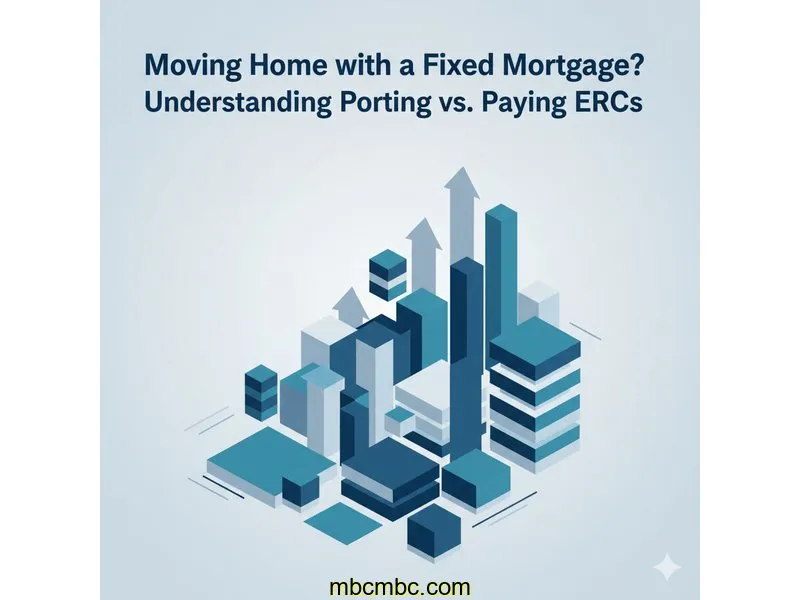
Hi, I'm Alex Williams, founder of FinTools UK. As a developer, I love breaking down complex processes into simple, understandable parts. One of the most common questions I see relates to moving house while 'locked in' to a fixed-rate mortgage. It's a classic scenario: you've found your dream home, but you still have two, three, or even five years left on your current mortgage deal. The immediate worry? The dreaded Early Repayment Charge (ERC).
Many people believe they are simply stuck, facing a penalty that could cost thousands of pounds. However, there's a common alternative that lenders offer: 'porting' your mortgage. This simply means taking your current mortgage product—with its specific interest rate and terms—with you from your old property to your new one. It sounds simple, but it's a full-fledged application process with its own set of rules.
This article will explain the difference between paying the ERC and porting your deal. We'll look at how each option works, what factors to consider, and how the process changes if you're upsizing or downsizing. This is purely informational, designed to help you understand the mechanics so you can have a more informed conversation with your lender or a mortgage advisor.
Quick Summary: Porting vs. Paying ERCs
- What is an ERC? An Early Repayment Charge (ERC) is a penalty fee, typically 1-5% of your outstanding loan, charged by lenders if you repay your mortgage (or overpay beyond your allowance) during a fixed-term or discount period.
- What is 'Porting'? Porting is the process of applying to your existing lender to transfer your current mortgage product (including its interest rate) to a new property when you move.
- Is Porting Guaranteed? No. You must re-apply and pass your lender's current affordability and credit checks. If your financial situation has changed, you may not be approved.
- The Core Trade-Off: Porting allows you to avoid the ERC and keep a low rate, but you're tied to your current lender. Paying the ERC frees you to shop around for a new deal with any lender, but it involves a significant upfront cost.
What Exactly is an Early Repayment Charge (ERC)?
Think of a fixed-rate mortgage like a mobile phone contract. You agreed to a 2-year contract in exchange for a guaranteed low monthly price. If you want to leave that contract early, the phone company charges you an exit fee. An ERC is the exact same concept for a mortgage.
When you take out a fixed-rate, discount, or tracker mortgage, you agree to stay with that product for a set period (e.g., 2, 5, or 10 years). The lender gives you a preferential rate based on that commitment. If you break this agreement by paying off the entire loan early—which is what happens when you sell your home—the lender charges an ERC to compensate for their potential loss.
These charges are not trivial. They are almost always calculated as a percentage of your **outstanding mortgage balance**. For example:
- Typical ERCs: Often tiered. A 5-year fix might have a 5% ERC in year 1, 4% in year 2, 3% in year 3, and so on.
- The Cost: A 3% ERC on a £250,000 outstanding mortgage is a £7,500 fee, payable upon sale.
This fee is the primary reason why 'porting' exists as a popular alternative.
The 'Porting' Process: Taking Your Mortgage With You

Porting your mortgage means you're essentially asking your lender to let you move your existing loan product from Property A to Property B. The product itself (your 2.0% fixed rate, for example) is 'ported', while the property securing the loan is switched.
A common misconception is that this is an automatic right. It is not. You have to formally **apply to your lender** to port your mortgage, and they will conduct a full underwriting assessment, just as they did when you first applied. This includes:
- Affordability Checks: They will re-assess your income and outgoings based on today's standards, not the standards from when you first got the loan.
- Credit Checks: A new credit search will likely be performed.
- Property Valuation: The lender will need to conduct a valuation on the *new* property to ensure it's suitable security for their loan.
This is a critical point. The Financial Conduct Authority (FCA) noted in 2023 that millions of borrowers are on low fixed rates set to expire in the coming years. If you're one of them, your lender will be assessing your porting application using today's higher interest rates and stricter affordability 'stress tests'. Even if your income hasn't changed, you may find it harder to qualify.
Scenario Comparison: Porting vs. Paying the ERC
The decision between porting and paying the ERC is a financial calculation. In the current high-interest-rate environment (2024-2025), most people are better off *keeping* their old, low rates. But the choice depends on your rate, the ERC cost, and new market rates. Here is a simple comparison of the two main scenarios.
| Consideration | Scenario A: Porting Your Mortgage | Scenario B: Paying ERC & Remortgaging |
|---|---|---|
| Upfront Cost | £0 ERC fee. You will still pay standard moving costs like valuation fees, and potentially lender admin fees. | Full ERC fee paid upfront (e.g., £6,000). You will also pay fees for the new mortgage product (arrangement, valuation). |
| New Mortgage Rate | You keep your existing rate (e.g., 2.5%) on the amount you port. Any *extra* borrowing is taken at the lender's current, higher rates (e.g., 5.0%). | Your entire new mortgage (e.g., full £300,000) is on a new product at current market rates (e.g., 5.0%). |
| Lender Choice | You are restricted to your current lender. You cannot shop around for better rates or more flexible terms. | You have full freedom to choose any lender on the market, allowing you to find the best possible deal available today. |
| Primary Benefit | Avoids a large ERC payment and (in the current market) preserves a valuable low interest rate on at least part of your loan. | Total flexibility. This is beneficial if new market rates are *lower* than your current rate, or if you need a product your current lender doesn't offer. |
| Key Risk | Your porting application could be rejected if you fail new affordability checks, forcing you to pay the ERC anyway. | A large, immediate cash expense. You also lose your (likely low) existing mortgage rate, leading to higher monthly payments. |
What if I'm Borrowing More (or Less)?
This is where porting can get a little more complex.
- Upsizing (Borrowing More): This is very common. Let's say you have £150,000 left on your 2.5% fixed rate, but your new home requires a £250,000 mortgage. Your lender will (if you're approved) 'port' the £150,000 at 2.5%. The extra £100,000 you need is a 'top-up' loan, which will be on a *new* mortgage product at your lender's current rates (e.g., 5.0%). You will then have two 'parts' to your mortgage, often with different rates and end dates.
- Downsizing (Borrowing Less): This can catch people out. If you have £150,000 left on your mortgage but your new home only requires a £100,000 loan, you are effectively "paying off" £50,000 of your fixed-rate loan early. In most cases, the lender will charge you a **partial ERC** on that £50,000 difference.
How Calculators Help Understand the Options
While a simple online tool can't model a complex 'port-and-top-up' scenario, our **mortgage calculator** is essential for assessing the 'Pay ERC' option. This is the other side of your calculation.
You can use the calculator to see exactly what your monthly payments would be on a *brand new* mortgage at today's market rates. For example, you can model a £300,000 loan over 25 years at a 5.0% interest rate. The calculator will show you the monthly payment and the total interest paid.
By comparing this new potential payment against your current payment, you can start to build a clear picture of the long-term cost. This allows you to weigh the one-off, upfront cost of the ERC against the long-term cost of a new, higher monthly payment. Seeing the numbers in black and white is the first step to understanding which path might be more suitable.
Common Questions About Porting and ERCs
Can I port my mortgage if I'm borrowing more for the new house?
Yes, this is a very common scenario often called a 'port-and-top-up'. Your lender will allow you to port your existing loan amount (e.g., £150,000 at 2.5%) and simultaneously apply for an additional loan (the 'top-up') at their current market rates. This is all subject to a full affordability and credit check on the total new loan amount.
What happens if there's a gap between selling my old house and buying the new one?
This complicates things, as most lenders require a simultaneous sale and purchase for a smooth port. If there's a gap (e.g., you sell and move into rented accommodation), many lenders will force you to pay the ERC upfront. However, some may offer a 'grace period' (e.g., 30-90 days) where you can claim the ERC back if you complete your new purchase within that window. This policy varies hugely by lender.
Is it sometimes better to just pay the ERC and get a new mortgage deal?
This entirely depends on the numbers. In a high-rate environment like 2024-2025, it's rare. Most people are porting to *keep* their old, low rates. However, if your current fixed rate was very high (e.g., 7%) and new market rates were suddenly much lower (e.g., 4%), the long-term savings from the new rate could easily outweigh the one-off ERC. It's a calculation of upfront cost vs. long-term monthly savings.
Conclusion: Understanding Your Options
Moving home while on a fixed-rate mortgage can feel restrictive, but you are not necessarily trapped. The key takeaway is that 'porting' is a common and viable solution that allows you to avoid the ERC and, in many cases, keep a highly valuable low interest rate. The most important thing to remember is that porting is not a given; it's a new application that you need to be approved for.
The decision between porting, porting-and-topping-up, or paying the ERC to move to a new lender is a complex one. This information is designed to give you a clear understanding of the *concepts* involved. Before making any decisions, it is essential to speak directly with your current lender to understand their specific porting policy and to review your mortgage offer, which will detail your exact ERC.

